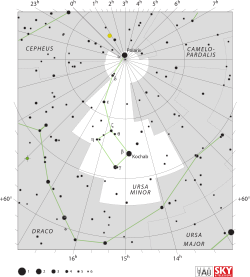Pi1 Ursae Minoris
| Pi1 Ursae Minoris (π1) | |
 | |
| Observationsdata Epok: J2000 | |
|---|---|
| Stjärnbild | Lilla björnen |
| Rektascension | 15t 29m 11,18599s[1] |
| Deklination | +80° 26′ 54,9713″[1] |
| Skenbar magnitud () | +6,58[2] |
| Stjärntyp | |
| Spektraltyp | G1.5V (n)[3] |
| U–B | +0,13[2] |
| B–V | +0,67[2] |
| Astrometri | |
| Radialhastighet () | -16,27 ± 0,09[4] km/s |
| Egenrörelse (µ) | RA: -224,25[1] mas/år Dek.: +108,19[1] mas/år |
| Parallax () | 45,77 ± 0,37[1] |
| Avstånd | 71,3 ± 0,6 lå (21,8 ± 0,2 pc) |
| Absolut magnitud () | +4,94 ± 0,04[5] |
| Detaljer | |
| Massa | 1,02[6] M☉ |
| Temperatur | 5 490[7] K |
| Metallicitet | -0,22[8] dex |
| Ålder | 9,22 ± 3,84[7] miljarder år |
| Andra beteckningar | |
| π1 UMi , ADS 9696, WDS J15292 + 8027 [9]
π1 UMi A: BD + 80 ° 480 , HD 139777, HIP 75809, HR 5829, SAO 2556 π1 UMi B: BD + 80 ° 481 , HD 139813, HIP 75829, SAO 2558 | |
Pi1 Ursae Minoris[10] (π11 Ursae Minoris, förkortat Pi1 UMi, π1 UMi) som är stjärnans Bayer-beteckning, är en dubbelstjärna i den norra delen av stjärnbilden Lilla björnen. Den har en genomsnittlig skenbar magnitud på +6,58[2] och ligger på gränsen för att vara synlig för blotta ögat även under de bästa observationsförhållanden. Baserat på parallaxmätningar i Hipparcos-uppdraget på 45,8[1] mas beräknas den befinna sig på ca 71 ljusårs (22 parsek) avstånd från solen.
Egenskaper[redigera | redigera wikitext]
Primärstjärnan Pi1 Ursae Minoris A är en gul till vit stjärna i huvudserien av spektralklass G1.5 V.[3] Den har en massa som är ungefär lika stor [6] som solens massa och en effektiv temperatur på ca 5 500 K.[6]
Följeslagaren Pi1 Ursae Minoris B är en gul till vit stjärna i huvudserien av spektralklass G9 V[11] med en skenbar magnitud av 7,31. Den har en vinkelseparation från primärstjärnan på 31,4 bågsekunder,[12] vilket motsvarar en fysisk separation av ca 680 AE,[13] och en omloppsperiod av cirka 13 100 år.[6] Båda är analoga med solen och förmodas ingå i Hercules-Lyra-föreningen, en av de till solen närmaste rörliga grupperna med gemensam rörelse genom rymden.[13]
Se även[redigera | redigera wikitext]
Referenser[redigera | redigera wikitext]
- Den här artikeln är helt eller delvis baserad på material från engelskspråkiga Wikipedia, Pi1 Ursae Minoris, 7 april 2019.
Noter[redigera | redigera wikitext]
- ^ [a b c d e f] van Leeuwen, F. (2007), "Validation of the new Hipparcos reduction", Astronomy and Astrophysics, 474 (2): 653–664, arXiv:0708.1752, Bibcode:2007A&A...474..653V, doi:10.1051/0004-6361:20078357.
- ^ [a b c d] Johnson, Harold L. (May 1953), "Photoelectric Observations of Visual Double Stars.", Astrophysical Journal, 117: 361, Bibcode:1953ApJ...117..361J, doi:10.1086/145700.
- ^ [a b] Gray, R. O.; et al. (July 2006), "Contributions to the Nearby Stars (NStars) Project: spectroscopy of stars earlier than M0 within 40 pc-The Southern Sample", The Astronomical Journal, 132 (1): 161–170, arXiv:astro-ph/0603770, Bibcode:2006AJ....132..161G, doi:10.1086/504637.
- ^ de Bruijne, J. H. J.; Eilers, A.-C. (October 2012), "Radial velocities for the HIPPARCOS-Gaia Hundred-Thousand-Proper-Motion project", Astronomy & Astrophysics, 546: 14, arXiv:1208.3048, Bibcode:2012A&A...546A..61D, doi:10.1051/0004-6361/201219219, A61.
- ^ Porto de Mello, G. F.; et al. (March 2014), "A photometric and spectroscopic survey of solar twin stars within 50 parsecs of the Sun; I. Atmospheric parameters and color similarity to the Sun", Astronomy and Astrophysics, 563: A52, arXiv:1312.7571, Bibcode:2014A&A...563A..52P, doi:10.1051/0004-6361/201322277.
- ^ [a b c d] Tokovinin, Andrei (2014), "From Binaries to Multiples. II. Hierarchical Multiplicity of F and G Dwarfs", The Astronomical Journal, 147 (4): 14, arXiv:1401.6827, Bibcode:2014AJ....147...87T, doi:10.1088/0004-6256/147/4/87, 87.
- ^ [a b] Pace, G. (March 2013), "Chromospheric activity as age indicator. An L-shaped chromospheric-activity versus age diagram", Astronomy & Astrophysics, 551: 4, arXiv:1301.5651, Bibcode:2013A&A...551L...8P, doi:10.1051/0004-6361/201220364, L8.
- ^ Casagrande, L.; et al. (2011), "New constraints on the chemical evolution of the solar neighbourhood and Galactic disc(s). Improved astrophysical parameters for the Geneva-Copenhagen Survey", Astronomy & Astrophysics, 530 (A138): 21, arXiv:1103.4651, Bibcode:2011A&A...530A.138C, doi:10.1051/0004-6361/201016276.
- ^ "** STF 1972AB". SIMBAD. Centre de données astronomiques de Strasbourg. Retrieved 2017-06-26. HD 139777 -- High proper-motion Star HD 139813 -- High proper-motion Star
- ^ Kepple, George Robert; Sanner, Glen W. (1998), The Night Sky Observers Guide: Spring & summer, 2, Willmann-Bell, p. 418, ISBN 0943396603.
- ^ Abt, H. A. (1981), "Visual multiples. VII - MK classifications", The Astrophysical Journal Supplement Series, 45: 437, Bibcode:1981ApJS...45..437A, doi:10.1086/190719.
- ^ Lépine, Sébastien; Bongiorno, Bethany (March 2007), "New Distant Companions to Known Nearby Stars. II. Faint Companions of Hipparcos Stars and the Frequency of Wide Binary Systems", The Astronomical Journal, 133 (3): 889–905, arXiv:astro-ph/0610605, Bibcode:2007AJ....133..889L, doi:10.1086/510333.
- ^ [a b] Eisenbeiss, T.; et al. (August 2013), "The Hercules-Lyra association revisited. New age estimation and multiplicity study" (PDF), Astronomy & Astrophysics, 556: 19, arXiv:1312.4045, Bibcode:2013A&A...556A..53E, doi:10.1051/0004-6361/201118362, A53.
Externa länkar[redigera | redigera wikitext]
| |||||||||||||||||||





